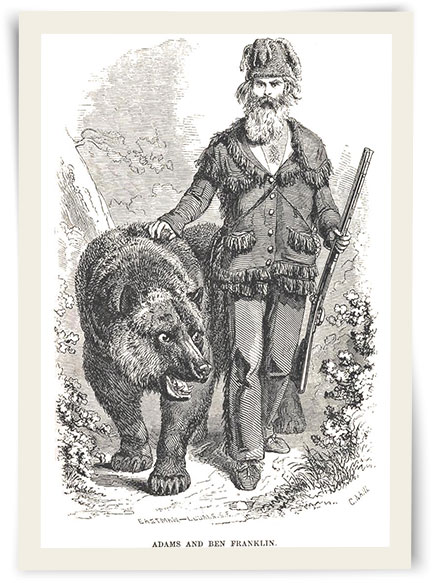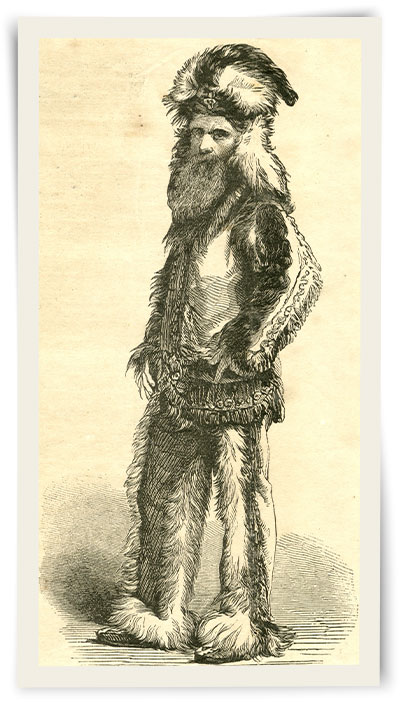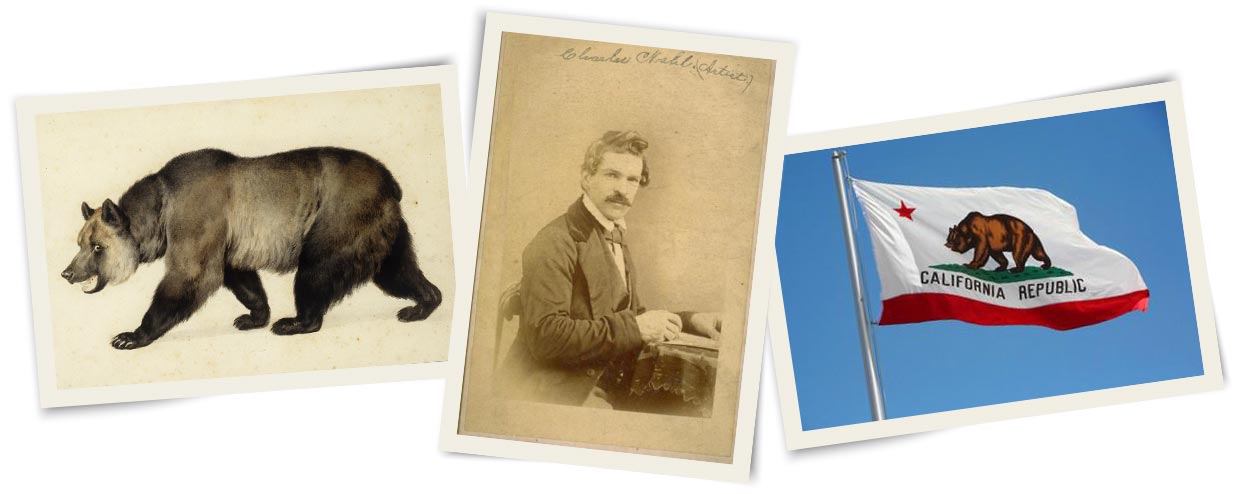Tracking the History of Grizzly Adams in
American Pop Culture

Above: Charles Nahl’s 1856 etching of Grizzly Adams with his bear, Ben, by his side. Adams came down from the mountains that year.
Part Four By Tod Swindell
©2018 The Grizzly Adams® Company
All humor aside, historically the real Grizzly Adams should mean more to Americans today. Here was a guy—John ‘Grizzly’ Adams—of the same family tree started in the U.S. by Henry Adams of Braintree, Massachusetts, the mountain man’s 4th generation great grandfather who came over from England in 1632, not too long after the Pilgrims arrived at Plymouth Rock. That’s right, the real ‘Grizzly Adams’ was one deeply rooted American whose famous cousins included Revolutionary War patriot, Samuel Adams, two United States Presidents, and a number of other eminent Americans. Born in 1812, he was one of seven siblings. He grew up to become a Boston shoe cobbler, until, while in his late thirties in 1849, his business failed when his inventory was destroyed by a major fire, leaving him to turn westward in an effort to recover his losses during the Great California Gold Rush. He joined the multitude of other eastern raised Americans lured by the vast, open frontier… that offered the possibility of striking it rich.
After enduring his arduous trek to California—and before he earned his “Grizzly” nickname—Adams spent a few years as a gold rush hopeful until he made the choice of abandoning the corrupt, greed-driven society that had quickly enveloped San Francisco and its surrounding boom-town communities. Adams—a mountain man to be—left all of that to “live deliberately,” as Henry David Thoreau once put it, in search of the peaceful refuge of the mountains. Thus, having abandoned civilization, he found himself compelled to traverse the western frontier—and during the next few years he cut an incredibly large swath extending from the southern Arizona desert, to the Los Angeles coast, up to and far beyond San Francisco both coastally and inland, on into the Oregon-Washington territory, and as far north as the Canadian border in what is now northwestern Montana. His return with a large menagerie of wild animals featured a trip to Portland along the Columbia River. Then later, from his cabin homestead near the Yosemite Valley in the Sierra Nevada range, he journeyed to Salt Lake City where happenstance left him part of an engaged crowd listening to a lecture delivered by none other than Brigham Young. From Adams’ own description of it, Young’s preaching left him somewhat confused.
Grizzly Adams was also an early advocate for the better treatment of Native Americans, whom he often scouted, hunted, and traded with. He was an archetype loner as well, though, who preferred having the wild denizens of the forests and mountains as companions over his fellow human beings. And while his prowess as a hunter was revered, it created a false rumor that said he ‘hunted for ten years in the mountains and killed scores of animals.’ NOT SO. Grizzly Adams was only briefly a mountain man who spent most of his time traversing and exploring the western frontier, and collecting animals. To be sure, he was as good a hunter as any, but he was only based in California’s Sierra Nevada range for a few years and he never wantonly killed animals. In other words, he was not a mountain man for as long as most people thought he was, and to him, to hunt was to survive. Not to leave out, where grizzly bears were still observed in California well into the Twentieth Century, it is unjust to try and pin their exodus from the state on his shoulders. Grizzly bears were hunted by Mexican vaqueros and white settlers in droves back then. People forget that mining camps and homesteaders mostly saw them as a threatening menace, and their meat, furs, and claws were commonly sought. There was no PETA or SPCA then either, and a hunter’s common ways, especially with iron traps, were much different in the 1850s; brutal in comparison to today’s standards. That’s history.
So we spare Grizzly Adams ‘the hunter’ there as a product of the time period he lived in. What is more recognizable anyway, is that he had ‘grown tired of hunting’ according to his own descriptions of his mountain man life—and why he abandoned it. Not to leave out, although he wasn’t a conservationist in the mold of a John Muir, Adams came to understand the individual natures of such a wide variety of wild animals that he practically qualified himself as a self-educated zoologist.
Briefly retracing Adams’ western steps, after his self-imposed exile from the gold rush camps, that lasted from late 1852 to early 1856, he moved back down from the Sierra Nevada with his impressive menagerie of live bears and other wild animals—to relocate in San Francisco. Once there, he became a celebrated showman with his ‘Mountaineer Museum Menagerie’ by performing in the city’s top venues. After a few years in the public spotlight, however, saddened by the death of his favorite bear, Ben, and with his own health beginning to fade, he decided the time had come to return to the east coast.
In January of 1860, Grizzly Adams left California to sail back to New York with his large menagerie of wild beasts. During the final year there he experienced some impressive notoriety as a performer for P.T. Barnum. Even so, he never had the slightest inkling that an 1855 painting of his mighty grizzly bear, Samson, done by gold rush era artist, Charles Nahl, would one day be re-rendered and transposed onto California’s state flag—where it has remained ever since. This is correct. Believe it or not, the same bear image that people have long been admiring on California’s state flag was derived from a painting of one of Grizzly Adams’ own bears.
While it is true today that most people over the age of forty-five associate Grizzly Adams with the popular NBC TV series and the late Dan Haggerty, the real Grizzly Adams’ indomitable legacy dwarfs everything that is associated with his famed moniker in modern-day pop culture. He truly was cut from the same cloth the famous frontiersmen, Daniel Boone and Davy Crockett were, although in many respects he was more formidable than either of them. For instance, when speaking of all of his wild animals, foremost including his mighty grizzly bears, Grizzly Adams once remarked that he was, “the toughest one of the lot.”
It appears evident enough today; he wasn’t kidding.

Above: Grizzly Adams in New York in an 1860 daguerreotype made by famous Civil War photographer, Mathew Brady, taken after P.T. Barnum gave Adams a fancier set of ‘showman’ threads.

Above: Famous western artist, Charles Nahl next to his 1855 painting of Grizzly Adams’ bear, Samson, was later re-rendered and transposed onto California’s State Flag.
“I have looked upon death in many forms, and trust that I can meet it whenever it comes with a stout heart and steady nerves. If I could choose, I would wish to finish my career in the Sierra Nevada. There would I lay down with Lady, Ben, and Rambler at my side; there I could find rest among the eternal rocks and evergreen pines.”
– Grizzly Adams

The term GRIZZLY ADAMS is a registered trademark of The Grizzly Adams® Company.
The Grizzly Adams® Company
8306 Wilshire Boulevard, #582
Beverly Hills, CA 90211
Email: [email protected]
